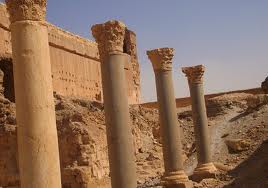Qasr al-Hayr al-Sharqi, or the “Eastern Castle”, is a castle in the middle of the Syrian Desert. It was built by the Umayyad caliph Hisham ibn Abd al-Malik in 728-29 CE. It was apparently used as a military and hunting outpost. The palace is the counterpart of Qasr al-Hayr al-Gharbi, a nearby castle palace built one year earlier.
Qasr al-Hayr al-Sharqi is 10 kilometres (6.2 mi) from al-Sukhnah and 100 kilometres (62 mi) from Sergiopolis (Rusafa), near Bishri Mountain near Palmyran Middle Mountains.
The palace consists of a large open courtyard surrounded by thick bulwarks and towers guarding the entrances as well as each corner. The palace consists of two square structures, one with a diameter of 300m and the other of 100 metres (330 ft). The palace(s) contains remnants of rooms, arches and columns which seem to be parts of a huge royal complex. Some of the decorated parts have been moved to the National Museum of Damascus while the gate has been reconstructed in the Deir ez-Zor Museum.
The bigger palace has been several floors, with a huge gate and many towers. Towers were not built as defensive measures. There were also olive yards. The palaces were supplied with water by nearby Byzantine church by a canal 5,700 metres (6,200 yd) long. The palaces contained bathrooms, water reservoirs, mosques and gardens.
This site was added to the UNESCO World Heritage Tentative List on June 8, 1999 in the Cultural category.
M.Wassouf

